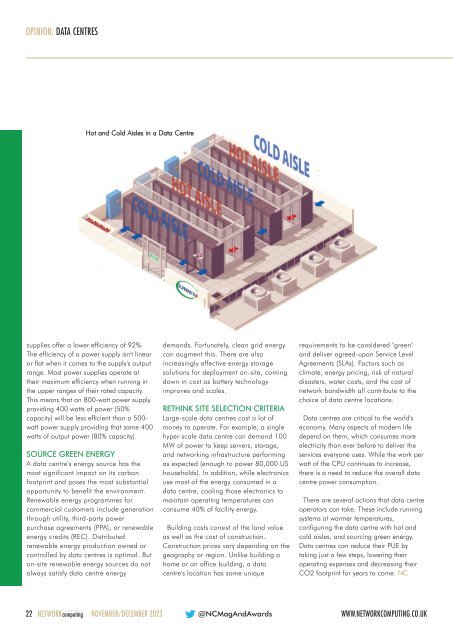NC Nov-Dec 2023
You also want an ePaper? Increase the reach of your titles
YUMPU automatically turns print PDFs into web optimized ePapers that Google loves.
OPINION: DATA CENTRES<br />
Hot and Cold Aisles in a Data Centre<br />
supplies offer a lower efficiency of 92%.<br />
The efficiency of a power supply isn't linear<br />
or flat when it comes to the supply's output<br />
range. Most power supplies operate at<br />
their maximum efficiency when running in<br />
the upper ranges of their rated capacity.<br />
This means that an 800-watt power supply<br />
providing 400 watts of power (50%<br />
capacity) will be less efficient than a 500-<br />
watt power supply providing that same 400<br />
watts of output power (80% capacity).<br />
SOURCE GREEN ENERGY<br />
A data centre's energy source has the<br />
most significant impact on its carbon<br />
footprint and poses the most substantial<br />
opportunity to benefit the environment.<br />
Renewable energy programmes for<br />
commercial customers include generation<br />
through utility, third-party power<br />
purchase agreements (PPA), or renewable<br />
energy credits (REC). Distributed<br />
renewable energy production owned or<br />
controlled by data centres is optimal. But<br />
on-site renewable energy sources do not<br />
always satisfy data centre energy<br />
demands. Fortunately, clean grid energy<br />
can augment this. There are also<br />
increasingly effective energy storage<br />
solutions for deployment on-site, coming<br />
down in cost as battery technology<br />
improves and scales.<br />
RETHINK SITE SELECTION CRITERIA<br />
Large-scale data centres cost a lot of<br />
money to operate. For example, a single<br />
hyper-scale data centre can demand 100<br />
MW of power to keep servers, storage,<br />
and networking infrastructure performing<br />
as expected (enough to power 80,000 US<br />
households). In addition, while electronics<br />
use most of the energy consumed in a<br />
data centre, cooling those electronics to<br />
maintain operating temperatures can<br />
consume 40% of facility energy.<br />
Building costs consist of the land value<br />
as well as the cost of construction.<br />
Construction prices vary depending on the<br />
geography or region. Unlike building a<br />
home or an office building, a data<br />
centre's location has some unique<br />
requirements to be considered "green"<br />
and deliver agreed-upon Service Level<br />
Agreements (SLAs). Factors such as<br />
climate, energy pricing, risk of natural<br />
disasters, water costs, and the cost of<br />
network bandwidth all contribute to the<br />
choice of data centre locations.<br />
Data centres are critical to the world's<br />
economy. Many aspects of modern life<br />
depend on them, which consumes more<br />
electricity than ever before to deliver the<br />
services everyone uses. While the work per<br />
watt of the CPU continues to increase,<br />
there is a need to reduce the overall data<br />
centre power consumption.<br />
There are several actions that data centre<br />
operators can take. These include running<br />
systems at warmer temperatures,<br />
configuring the data centre with hot and<br />
cold aisles, and sourcing green energy.<br />
Data centres can reduce their PUE by<br />
taking just a few steps, lowering their<br />
operating expenses and decreasing their<br />
CO2 footprint for years to come. <strong>NC</strong><br />
22 NETWORKcomputing NOVEMBER/DECEMBER <strong>2023</strong> @<strong>NC</strong>MagAndAwards<br />
WWW.NETWORKCOMPUTING.CO.UK
















